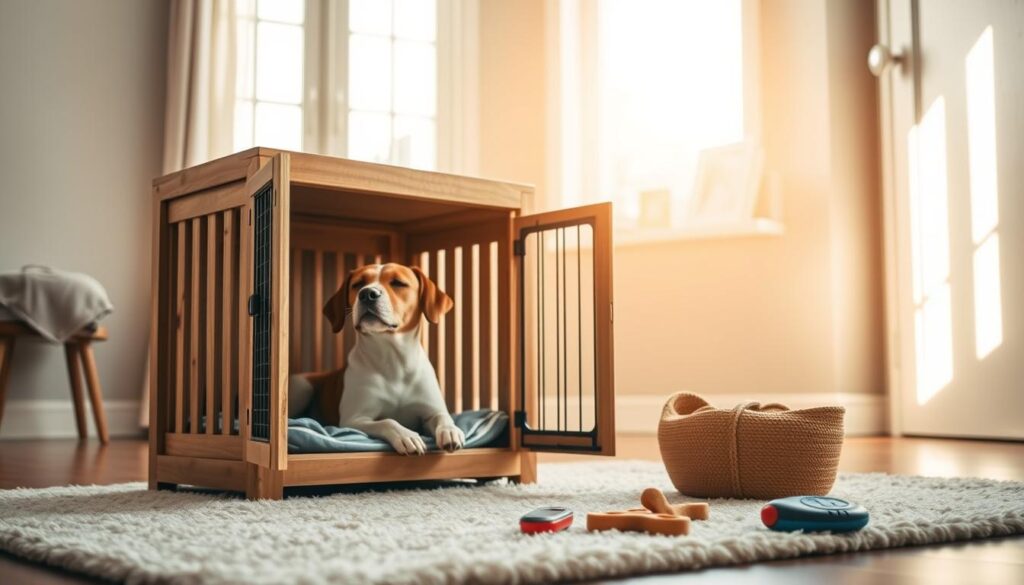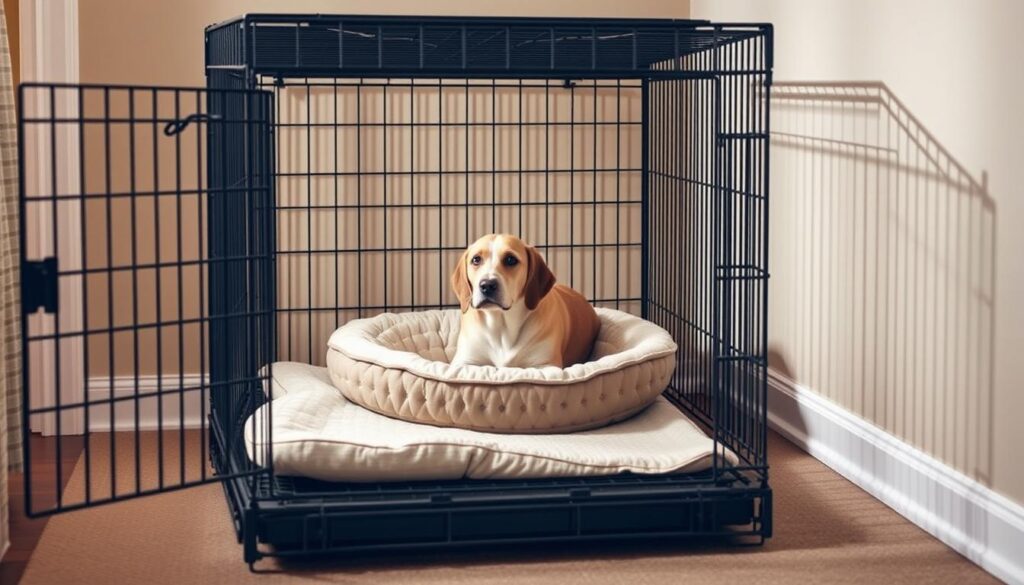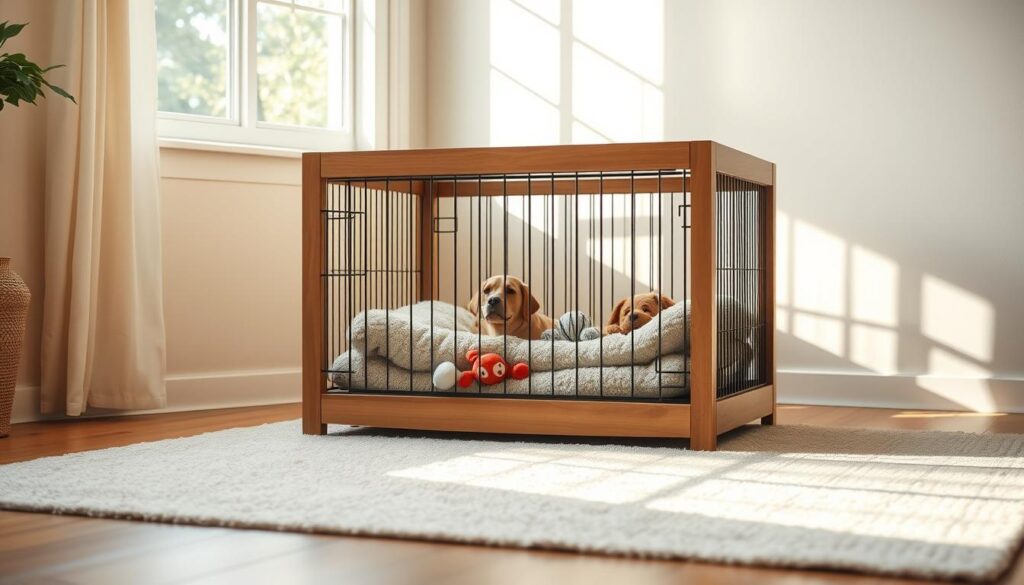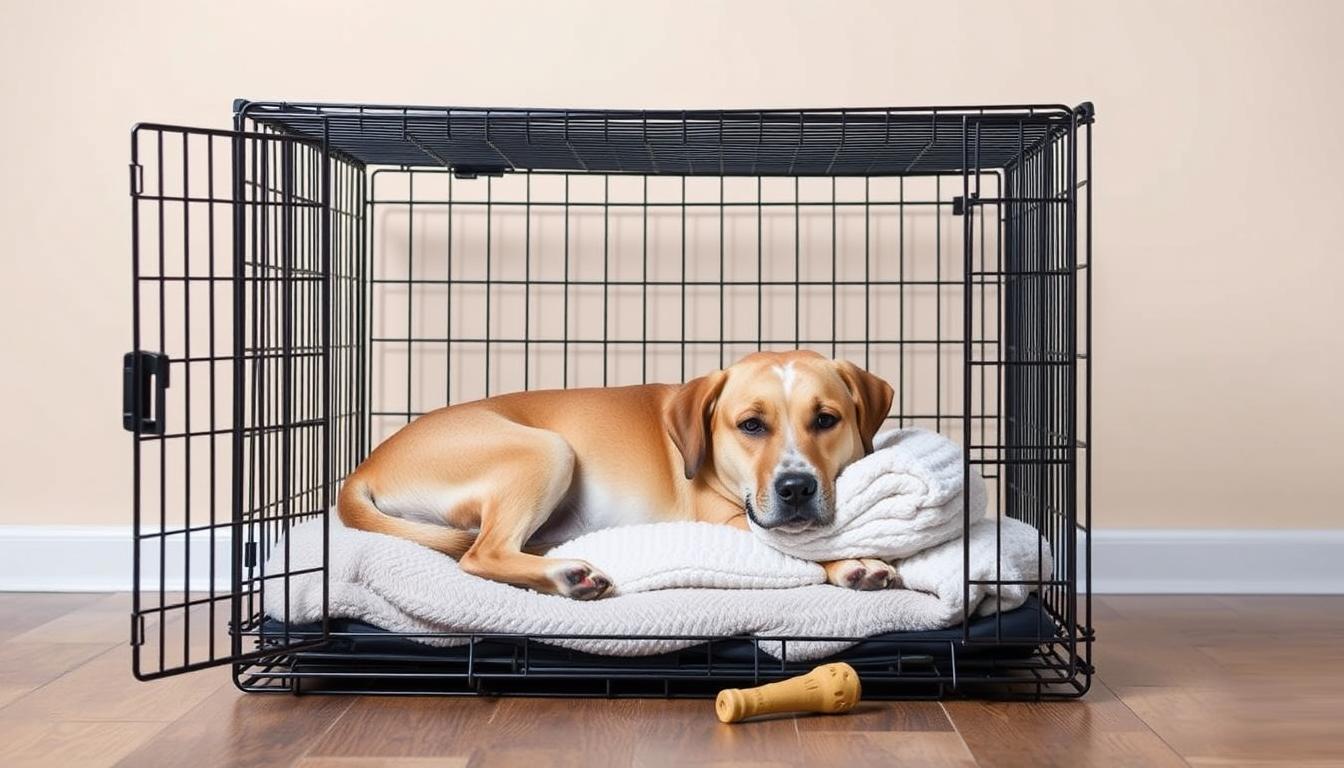Crate training is a great way for dog owners to manage isolation barking. It makes dogs feel safe and helps cut down on barking. Owners can introduce the crate in a positive way, step by step.
The Animal Humane Society says crate training can take days or weeks. It depends on the dog’s age, personality, and past experiences. Start with short times in the crate and slowly increase it.
This method helps with separation anxiety and barking. Use positive reinforcement like treats and praise. This makes the crate a good thing for your dog, making training easier and more successful.
Understanding Isolation Barking in Dogs
It’s important to know why dogs bark when left alone. Isolation barking is a common problem for many dog owners. It can be caused by different things.
Separation anxiety is a big reason for isolation barking. Dogs with this issue get very upset when left by themselves. They bark a lot. Other reasons include boredom, not enough training, outside noises, and health problems.

| Causes of Isolation Barking | Description |
|---|---|
| Separation Anxiety | Dogs become distressed when left alone, leading to excessive barking. |
| Boredom | Lack of mental and physical stimulation causes dogs to bark. |
| Lack of Training | Insufficient training leads to barking due to lack of discipline. |
| External Stimuli | Noises or other external factors can trigger barking. |
| Medical Issues | Pain or discomfort can cause dogs to bark excessively. |
To solve isolation barking, you need to find out why it’s happening. If it’s because of separation anxiety, boredom, or something else, you can take steps to help.
Good solutions might include crate training, giving them enough exercise and mental games. You can also use techniques to help them feel less anxious when you’re away. Knowing about dog behavior and anxiety in dogs helps you find the best ways to stop the barking.
The Connection Between Crate Training and Reduced Barking
Crate training helps dogs feel safe and comfortable. This reduces barking caused by separation anxiety. Dogs with a crate have a cozy place to relax when left alone.
Training a dog to be calm in a crate can stop barking. It helps when dogs bark due to outside noises. For tips on stopping dogs from barking when you’re away, check this resource.

- Providing a safe and secure environment for the dog
- Reducing separation anxiety and associated barking
- Preventing external stimuli from triggering barking
Using crate training can greatly lessen barking from separation anxiety. It’s key to start slowly and make the crate a cozy spot for your dog.
Selecting the Right Crate for Your Dog
Choosing the right dog crate is key for crate training and your dog’s comfort. The crate should be a safe space. It should let your dog stand up, turn around, and lie down comfortably.
Size and Type of Crate
The size of the crate is crucial. A crate that’s too small is uncomfortable. One that’s too big may not feel cozy to your dog. Look for a crate with adjustable dividers for your dog’s growth, if you have a puppy.
The crate type matters too. Crates are made of wire, plastic, and fabric. Wire crates are good for air and visibility. Plastic crates offer a secure feel. Fabric crates are light and easy to carry but might not be good for chewers or escape artists.

The best dog training equipment, like the crate, meets your dog’s needs and your training goals. Make sure the crate is sturdy, well-ventilated, and easy to clean.
Essential Crate Training Tips To Minimize Isolation Barking
To cut down on isolation barking, start crate training slowly and positively. Crate training is great for dog owners. It makes a safe space for dogs and lowers barking from being alone.
Gradual Introduction to the Crate is key. First, leave the crate door open for your dog to get used to it. Put treats and toys inside to make it inviting.
- Start with short crate times, like during meals or when you’re home.
- Slowly increase crate time as your dog gets more comfortable.
- Don’t forget to give your dog enough exercise and mental play outside the crate.
Positive Reinforcement is vital for crate training success. Praise and reward your dog for being calm in the crate. Use treats or words of encouragement when they act calm or go into the crate on their own.
| Crate Training Tip | Description | Benefit |
|---|---|---|
| Gradual Introduction | Start by opening the crate door. | Lessens anxiety and stress. |
| Positive Reinforcement | Give treats or praise for calm behavior. | Makes the crate a positive place. |
| Consistency | Stick to a regular crate schedule. | Builds a routine and cuts down on barking. |

Being consistent is crucial for crate training. Set a regular crate time and make sure everyone agrees. This helps your dog know what to expect, reducing barking when alone.
By using these crate training tips, you can lessen isolation barking. This makes your home a happier place for both you and your dog.
Establishing a Consistent Crate Training Schedule
To crate train a dog well, a consistent schedule is key. This helps dogs learn good habits and feel secure. It also stops them from getting confused or anxious.
A good crate training schedule is essential. It sets a routine for crate time, exercise, and play. This makes the dog feel safe and helps them develop good habits.
Here’s a simple plan for a dog training plan that includes crate training:
| Time of Day | Activity | Duration |
|---|---|---|
| 8:00 AM | Crate Training | 2 hours |
| 10:00 AM | Exercise/Play | 1 hour |
| 12:00 PM | Lunch Break | 1 hour |
| 1:00 PM | Crate Training | 2 hours |
| 4:00 PM | Exercise/Play | 1 hour |
Following this crate training schedule is important. It keeps training consistent, which is good for the dog’s mind and heart. This routine helps reduce barking and makes your home quieter and happier.
Desensitization Techniques for Departure Cues
To reduce separation anxiety, it’s key to use desensitization techniques for departure cues. These cues tell your dog you’re leaving, like picking up keys or saying goodbye. It’s important to understand and apply these techniques well.
Desensitization means slowly getting your dog used to these cues without actually leaving. Begin by doing your departure cues at random times when you’re still at home. For instance, pick up your keys and then put them back down. Or, put on your coat and then take it off.
Do this several times a day. It helps your dog see that these cues don’t always mean you’re leaving. Being consistent and patient is crucial. Desensitization takes time and needs repetition.
Using desensitization techniques can lessen your dog’s separation anxiety. This method, along with dog training, can make your departures less stressful for both you and your dog.
Enrichment Activities to Keep Your Dog Calm in the Crate
Crate training can be tough, but the right activities can help. Toys, puzzles, and treats keep your dog calm and busy. Types of Enrichment ActivitiesHere are some ways to keep your dog calm in the crate:
- Interactive puzzle toys filled with treats
- Sensory toys with different textures and smells
- Hide-and-seek games with treats or toys
- Calming aids like pheromone diffusers or calming music
These activities keep your dog’s mind active and can lower barking. For more tips on reducing barking, check out our article onhow to stop your dogfrom.
Adding these activities to your crate training routine helps your dog stay calm. It also reduces barking. Remember to change toys and activities often to keep your dog interested.Benefits of Enrichment ActivitiesThe benefits of enrichment activities for crate training include:
- Reduced barking and whining
- Increased calmness and relaxation
- Improved mental stimulation and engagement
By making your dog’s environment stimulating, you create a happier home. This is good for both you and your dog.
Addressing Setbacks in Crate Training
Dealing with setbacks in crate training can be tough. But, there are ways to get past them. Understanding how to handle these challenges is key to success.
Many dog owners face issues like whining, barking, and escaping. These problems can upset both the dog and the owner. Consistency and patience are key to solving these problems.
To stop whining and barking, ignore the behavior until it stops. Then, reward the dog for being calm. To prevent escaping, make sure the crate fits right and the dog isn’t in it too long.
- Ensure the crate is well-ventilated and comfortable.
- Increase exercise and mental stimulation before crating.
- Gradually increase the time spent in the crate to prevent anxiety.
By following these tips and staying committed, owners can beat crate training setbacks. This is a big step towards a well-behaved and calm dog.
Complementary Training Methods to Support Crate Success
To make crate training work, you need to add other training methods. Using crate training with obedience and positive reinforcement can make it better.
Obedience training helps a lot. It teaches your dog to behave well, which means less barking in the crate.
Positive reinforcement is also key. It rewards your dog for good behavior, like calmly going into the crate. This makes the crate a positive place for your dog.
| Training Method | Description | Benefits |
|---|---|---|
| Obedience Training | Teaching basic obedience commands | Improves overall behavior, reduces barking |
| Positive Reinforcement | Rewarding desired behaviors | Creates positive crate association, smooths training |
| Desensitization Techniques | Reducing reaction to departure cues | Minimizes anxiety, reduces barking |
Using these methods can help your crate training succeed. It makes your home a happier place. Just remember, it takes time and patience to see results.
When to Consider Professional Help
Knowing when to get professional help is key for dog owners facing crate training and separation anxiety. Crate training works well for many dogs. But, some may need extra help if they have serious behavioral problems.
If your dog is still upset or crate training isn’t working, it’s time to talk to a professional dog trainer or behaviorist. They can give you specific advice and help create a training plan that fits your dog’s needs.
The table below shows signs that mean you might need professional help with crate training:
| Signs of Distress | Description | Potential Solution |
|---|---|---|
| Excessive Barking | Persistent barking or howling when crated | Desensitization techniques, crate training adjustments |
| Destructive Behavior | Damaging crate or surrounding area | Increase exercise, mental stimulation, and crate training |
| Escape Attempts | Repeated attempts to escape the crate | Strengthen crate training, consider a different crate type |
Getting crate training help from a pro can make your dog much happier. It can also lessen separation anxiety. By knowing when to ask for help, you can make a better training plan. This will lead to a better, healthier bond with your dog.
Conclusion: Creating a Happier, Quieter Home Environment
Successful crate training can make both dogs and their owners happier. It leads to a quieter home. Understanding how crate training reduces barking is key to a peaceful home.
Crate training offers many benefits. It improves dog training and makes dogs feel secure. Choosing the right crate and following a consistent training schedule are crucial.
By doing so, barking decreases, making the home quieter. Following the tips in this article helps owners achieve a happier, quieter home. It also strengthens the bond between dog and owner.
Investing in crate training is good for a dog’s behavior. It brings long-term benefits to both the dog and the home. Adopting these strategies leads to a more harmonious home, with better training outcomes and peace.






